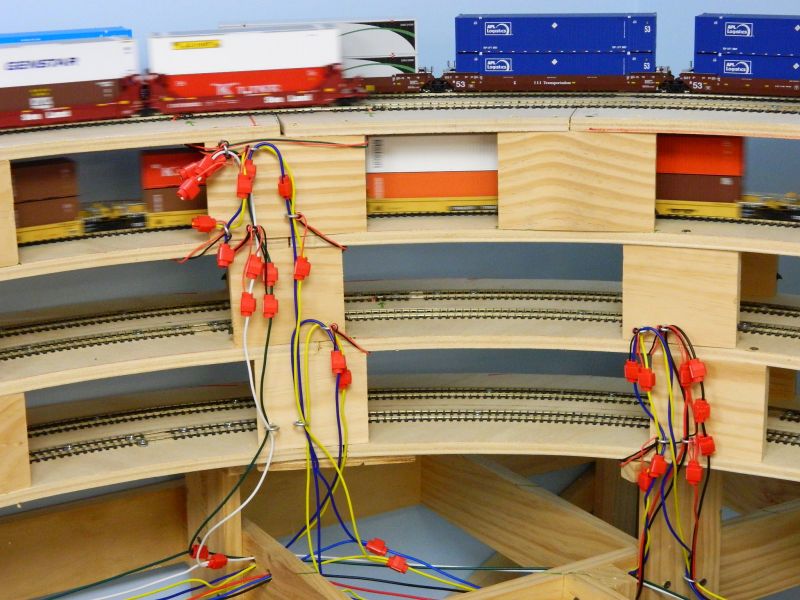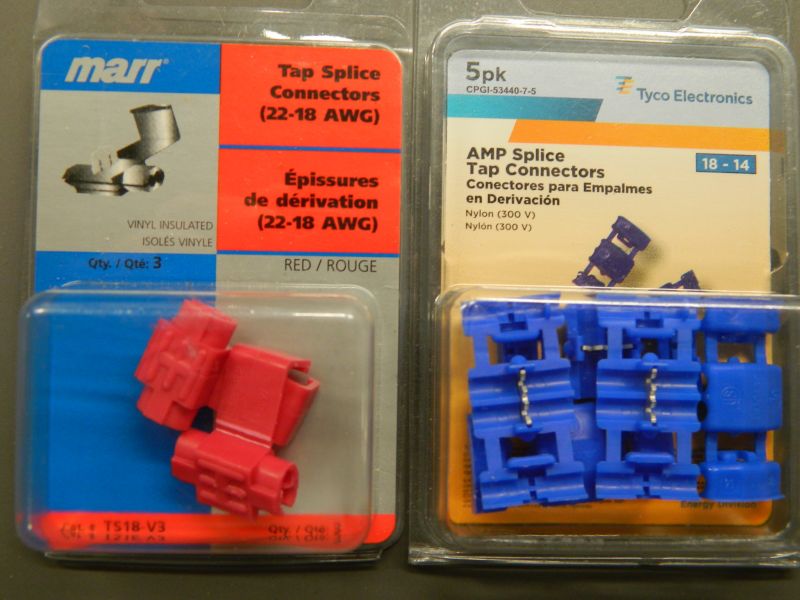Wiring the layout (and including DCC)
Posted
#243483
(In Topic #13438)
Full Member
An irreverant look at various methods for getting power from a to b (or not)
Hi all,I decided to start a topic on how to wire a layout, mainly focused on DCC, but most of this will apply to DC as well. Throw in your 2-cents/pence worth based on your own experiences by all means, I'll try and cover the good, the bad and the "who'd a thought it" stuff I've come across over the years.
Scotchloks (suitcases, clam-shells). Used to connect rail droppers to the bus. You either love love 'em or hate 'em. Saw this the other day on a double track helix at a layout tour - they must have been breeding:

They are fine if used correctly, more on that in the next post, because they can come back and bite you if not used correctly.
Nigel
©Nigel C. Phillips
Posted
Full Member
North America = AWG, Europe = metric, Australia seems happy with just the diameter/area (sensible, but Ron will correct me) so what's what? Most of the standards for wiring for DCC come from over where I live, the metric world follows an IEC standard, so let's have a quick summary of the nearest equivalents using commonly recomended gauges (metric is in mm squared).
12-14 AWG, commonly used for the bus wiring. 2.5mm or 1.5mm.
18 or 20 AWG, commonly used for rail dropper to bus wiring: 1mm or 0.5mm.
Dont worry about using even smaller diameter wires (22 gauge for example) unless you have more than a brace of engines on a wired section the current is unlikely to exceed the wire rating. Metric stops at 0.5mm, so even less of an issue.
Now all of this has an impact on Scotchloks and other brand tap connectors. They work with a large diameter wire (the tap) feeding a smaller diameter wire (the connector) using a blade that cuts through the plastic insulation and contacts the bare wires without cutting through them. Two examples of AWG taps are shown below. And here is an issue - it is difficult to use just one tap connector in going from a 14 gauge bus to a 22 gauge dropper without using 2 taps in series. And it looks like the same issue will apply to metric sizing. Red Connectors: 0.4mm - 1mm. Blue Connectors: 1.1mm - 2.6mm. Yellow Connectors: 2.5mm - 6.5mm. Which I suspect is based on AWG sizing as none of the sizes are IEC. Plus they are supposed to be used with solid core, not stranded wire, the latter will have strands cut during compression.
Nigel

©Nigel C. Phillips
Posted
Full Member
We have recently had a number of members asking should I go DCC? Which is a reasonable question. Pretty much the dilemma faced by previous generations of modelers making a choice between clockwork versus AC motors.
The use of DCC in the UK is probably 10 years behind the U.S. or Canada, where we are currently getting to grips with LCC as an extension to DCC. DC layouts here are as rare as hen's teeth, so most newcomers to the hobby to straight into the DCC world. As electronic timelines go it should be considered as a mature technology, not something new.
It is not just about sound, although that can add an interesting dimension. It really is about controllability and adjustable running. DCC electrical supply is half-width AC around 14 -17V onto which is superimposed a very high frequency digital control signal which can address up to 9,999 locomotives independently That tells the decoder what to do, including converting the AC current back into DC (or AC, but that's another story). Where this differs from old voltage regulated DC is that the motor is driven by pulses of full voltage DC, which really improves running at slow speeds. This is termed pulse width modulated control (PWM). This is also found on modern DC controllers.
If you run one locomotive at a time, and you don't care about sound, a good (= expensive) DC control system with PWM is fine with modern locomotives. There are stand-alone sound systems for DC if you feel the urge for whistles or horns, or chuffs or diesel rumbles. If you run more than one locomotive at a time DC needs block control, which is what the prototype does. Great if you like hands-on control and lots of switches and wiring to make sure the two or more locomotives are separated electrically. All of that can be avoided with DCC. I sometimes take part in running on a DCC modular club, anything up to 8 locomotives on two tracks all independently controlled.
DCC (and LCC) can control almost anything, including points (even solenoid ones), turntables, lights, electromagnetic uncouplers, shed doors….most systems have macro functions where for example a series of points can be thrown with just a couple of button pushes. Go the full monty and control it all from a computer touch screen! Radio or IR control if you want it.
My advice to any modeler looking at DC versus DCC is to make a list of what you want, and determine which system fits you needs before you start wiring. Do some research on the various systems out there. there are some excellent primers in DCC on the web. A good DC control system is comparable in price to a DCC one. Luckily when I started in the hobby 15 years ago I joined a club that was transitioning from a large DC layout with multiple block control to a DCC layout. What a difference! My (one and only) home DC layout got dismantled.
Me? My layouts are all DCC controlled, and I install the decoders myself. I have a DC controller, essential for testing a locomotive before putting a decoder in. You can get decoder installation done for you, but quite frankly it is not that difficult and can save some money. With modern locomotives it mostly consists of removing the DC jumper from the circuit board and plugging in the decoder and finding some space for the speaker. Older DC or early DCC ready locomotives can be challeging, but in all cases doable. The various lights on modern diesel locomotives can realistically only be controlled using DCC.
One comment on layouts where young children are going to run trains. The concept of negative feedback is totally foreign (too fast, reduce speed). DCC handles that by limiting the maximum speed. No more trains leaping off the track. Which can get expensive.
©Nigel C. Phillips
Posted
Full Member
Having been a modeller for nearly 50 years I am, of course, an ardent DC follower but recognise that I am not the future of the hobby. That responsibility lies with my grandson. I recently bought him a train set - DC of course because thats what you get when you buy a cheap set - but I would fully expect him to take to it as I did (the signs are already there) in which case the next logical step is a cheap DCC train set.
In 5 years time when he is old enough he will be fitting decoders and speakers like we used to fit 3-link couplings and think nothing of it. However, by then, I expect the UK market will be totally dominated by DCC sound-fitted locomotives and I will be an odd-ball trying to find DC engines or unlit coaching stock.
I agree with your comments that it is important to set DCC as the entry point and drive technology upwards towards LCC. I think we are over the "which system" debate (a bit like the Beta/VHS video format debate of old) so newcomers should be encouraged to dive straight in and gain all the benefits.
My only reservation is price. In 1976 a Hornby Jinty was £4.90 [source = Hornby website] representing 2 1/2% of my (then) monthly salary. A current sound-fitted loco at £200 is 14% of my son's salary - and he is a graduate professional in a decent job.
I have no desire to de-rail or hijack the thread but it would be interesting to compare this with the US where the technology is clearly in front of where we are.
Barry
 Last edit: by Barry Miltenburg
Last edit: by Barry Miltenburg
Shed dweller, Softie Southerner and Meglomaniac
Posted
Full Member
Comment away, that is what this topic is about.
Price is certainly a barrier. Especially with a new locomotives and DCC sound. One way around this is to buy a good used DC model, and install a decoder. The last time I bought a new model was probably 10 years ago.
Like you, I suspect, I really can't fathom why anybody coming into the hobby would not give serious thought to diving right in with DCC. Nostalgia perhaps. The wiring complexity can get about the same for both, Where DCC really comes out ahead is in medium to large layouts. My layouts are usually small, with only one locomotive at a time, DC would be a very viable option, but try getting a locomotive to creep along at a foot a minute! And it's nice to have the correct long and short whistles when shunting.
LCC looks interesting, but the issue there is one of large layouts, bandwith, and delayed signals to decoders. I am personally not convinced that there is any real benefit with a small layout where the loconet or equivalent is not being used to full capacity.
It has been calculated that the investment in just the layout (boards, track, scenics) is between $100-$300 a foot for a 2-foot wide setup. I was looking through the scouse emporium yesterday, that tasty looking Heljan 0-6-0 saddle shunter is £136, £284 with DCC sound. Going on a rough rule of thumb of one locomotive very 5 feet, that's an investment of £2500 for the layout, £560 for the locomotives. Not a bad ratio at 20%, and if you figure you should be paid for all that hard work in building it, it's a steal.Even better if you install the decoder yourself and save £25-£30.
I am an advocate of using older stock as training items. Better to goof up on a £40 locomotive that a £300 one. And after weathering they look pretty much the same anyway. Remember this is OO, with an intrinsically and hopelessly out of scale chassis.
Nigel
©Nigel C. Phillips
Posted
Full Member
Apologies!!
Barry
Shed dweller, Softie Southerner and Meglomaniac
Posted
Full Member
Not to worry, anything to do with DC or DCC involves wiring, even RC control. There does seem to be an assumption that DCC wiring is just connecting 2 wires and it's off to the races. It ain't necessarily so. Folks get surprised when It turns out to be just as complicated as DC. Wyes, turntables and reverse loops are good examples which in DC would be addressed by toggles, DCC sound requires circuit boards capable of switching polarity faster than the decoder shutting down or creating a short.
Nigel
©Nigel C. Phillips
Posted
Full Member
The main point about Scotchloks is to ensure you use the correct size for your bus wire. For 2.5mm bus it's the blue ones, for 1.5mm then the red ones.
Robert
Posted
Full Member
Works for me. I like the ones with the long levers. Good amp ratings as well, and not expensive.
Nigel
©Nigel C. Phillips
1 guest and 0 members have just viewed this.

